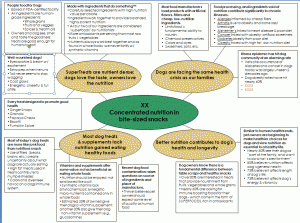 In a high-level discussion with a colleague recently, we surmised there are three buckets in which we play in the social media world:
In a high-level discussion with a colleague recently, we surmised there are three buckets in which we play in the social media world:
App developers
Big data masters
Content marketers
Although these three seem siloed; in fact, they’re not. The common thread is content marketing, where I play.
- Everyone expecting to deliver a successful app to the space requires spot-on messaging to enhance content.
- Anyone dissecting analytics and big data for marketers requires spot-on messaging to deliver the analysis for use in content marketing.
- Anyone executing content marketing requires message mapping to deliver spot-on messaging.
What is Message Mapping?
There still seems to be great confusion about when to use a message map or if a mind map will suffice. I’d like to shed more light on this topic and help business owners understand the importance of each.
This is a core public relations tool used at the start of any strategic campaign and also prior to launch of a business. A message mapping exercise can be executed any time, actually. If a leadership team is interested in tweaking and perfecting messaging to launch new products or services, or complete a merger or acquisition, then a message map comes into play. Sales teams can even use message maps, as well.
When you develop a message map, a three-hour session with an integrated leadership team is drilled down to a messaging platform that becomes a creative suite of sound bites. Everyone likes to call it the elevator speech. It is and it’s so much more.
Message maps allow the encapsulation of a story about a company’s history, its products, its services, its people/founders, its competitors, its pricing, and industry all within one map that looks like a hub with quadrants and sub-sections.
When questions are asked of an executive, the message map provides all the prompts for the answer and then some. I’ve known executives to minimize the map and keep it in their wallet for easy reference. Nowadays, it’s easier to pull it up via mobile device.
As a content marketer, I recognize how critical a message map is to the success of any social media marketing campaign. I prefer to use a message map or messaging platform to draft social media posts for Twitter and Facebook. I prefer to reference a message map to ensure that approved language is added to corporate blog posts, too.
When there isn’t a message map, there is no unified voice. Think about that. Most of my clients that are smaller don’t want to invest in message mapping exercises. When they don’t, there is no approved corporate content to communicate externally. Messages become a tangled web and the team can become confused how to communicate and best portray the company.
For anyone starting or dabbling in social media marketing, I encourage this exercise. The outcome provides a foundation to build upon as your company grows. It is a critical component to the success of your positioning and the strength of your brand.
Lastly, a message map is NOT a mind map. From what I understand, mind maps allow for the tracking of tasks, actions and future programs via in-depth schematic like a roadway. Still confused? Ask me; ready to shed more light any time.






